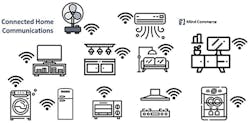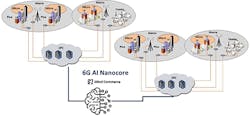New Spectrum and Frequencies and a New Future —
Just as the jump from 4G to 5G represents an expansion of spectrums used and introduction of new frequencies, so will the evolution between 5G and 6G communications. Whereas 5G leverages mmWave in the microwave frequency range, 6G will take advantage of even smaller wavelengths at the Terahertz (THz) band, which is typically referred to as 100 GHz to 3 THz.
Just as there have been, and will continue to be, many challenges with 5G, so will there be many new challenges with 6G. One of those challenges will be developing commercial transceivers at the to-be utilized THz frequencies. This is largely an area in which electronics component providers will need to innovate. For example, semiconductor providers will need to deal with extremely small wavelengths and correspondingly small physical size of RF transistors and how they will interwork with element spacing of THz antenna arrays.
Many More Radio Access Points
While the impact to the Radio Access Network (RAN) for 5G is substantial, it will potentially be even bigger with 6G networks, which is driven largely once again by a substantial increase in frequency causing the need for antennas virtually everywhere. This has a huge implication for the current site planning and the hosting business as the trend towards increasingly more distributed service access, which started with 5G (e.g., neutral hosts and distributed service providers), will accelerate dramatically with 6G.
InvisiLight® Solution for Deploying Fiber
April 2, 2022Go to Market Faster. Speed up Network Deployment
April 2, 2022Episode 10: Fiber Optic Closure Specs Explained…
April 1, 2022Food for Thought from Our 2022 ICT Visionaries
April 1, 2022It’s highly likely that wireless networks will evolve to become more of a communications mesh as opposed to the current hub-and-spoke type configuration. In this mesh arrangement, there may be a complex interconnected web of RF signals that serve as access points as well as node-to-node connectivity and backhaul for larger frequency aggregation hubs, currently known as cell sites. In other words, the future of the RAN may evolve from today’s world (e.g., dependency on legacy carrier hubs for macro WAN communications and WiFi for local hotspots) to a much more distributed radio access system.
Figure 1. Today’s World: Local and Personal Area Networks
Putting this into perspective in today’s world, the connected home represents the ability for consumer durable goods to communicate wirelessly to a gateway for wide area network (WAN) communications, typically via cellular or fixed network Internet access as shown in Figure 1. In tomorrow’s world, each of these items will likely have the ability to function as a 6G access point to the WAN. (See Figure 2.)
Figure 2. The World of 6G: Everything Can Be an Access Point
This means that any other small object with embedded wireless communications could communicate with virtually anything else in the world without going through a gateway point. Individual objects may also communicate with each other in a peer-to-peer arrangement as well.
Changes to Core Networks
To some extent, 6G networks will continue the evolutionary path driven by 5G, which includes increasingly more autonomous networks, advanced quality of service and experience optimization, edge computing, and a service-based architecture approach. However, there is also the potential for much more profound core network changes with 6G, which may occur coincident with the technology convergence.
For example, Mind Commerce and others have discussed in the past the potential for a so called "nano-core" to emerge as a common computing core that encompasses elements of high performance computing (HPC) and artificial intelligence (AI).
Figure 3. Common AI "Nanocore" a Potential Change to ICT Infrastructure
Assuming this potential vision is realized, the nano-core need not be a physical network element, but rather a logical comprised of a web of computational resources, shared by many networks/systems. (See Figure 3.)
Evolution of the Datacenter
Datacenters are already faced with big changes due to 5G such as virtualization, programmable networks, edge computing, and issues surrounding simultaneous support of public and private networks. For example, some business customers may want a combination of on-premise RAN, hybrid on-premise and hosted computing (e.g., for edge and core computing respectively), and datacenter hosted core network elements for private business networks and/or alternative service providers.
Datacenters will also need to evolve as data storage, processing, and sharing needs also evolve.
With substantially more data created by 6G (than 5G networks), and the evolution of computing to include coordination between edge and core platforms, the need for datacenter evolution will be paramount.
In addition, next-generation 6G capabilities in the areas of sensing, imaging, and location determination will generate vast amounts of data that must be managed on behalf of the network owners, service providers, and data owners.
The aforementioned changes will facilitate the need for datacenters to rapidly expand to scale along with the associated growth of data storage, processing, and exchange with data owners, custodians, and users.
6G Technology Convergence
More than ever before, 6G technology will represent an integrated set of previously disparate technologies. Several key technologies will converge with 6G including AI, big data analytics, and computing.
The introduction of 5G paves the way for much of this convergence, such as the need to deploy edge computing to ensure overall throughput and low latency for URLLC solutions as well as supporting mMTC in the form of many low-power IoT devices that do not have their own on-board computing.
Whereas the addition of mobile edge computing (MEC) is a point of consideration as an addition to 5G networks, MEC will be built into all 6G networks. Edge and core computing will become much more seamlessly integrated as part of combined communications/computation infrastructure framework by the time that 6G networks are deployed.
This will provide many potential advantages as 6G technology becomes operational such as improved access to AI capabilities. Working in conjunction with AI, computational infrastructure will be able to autonomously determine the best location for computing to occur, which shall include decisions about storage, processing, and data sharing.
6G Capabilities and Opportunities
Despite the many challenges associated with 6G RF signals, there are many potential advantages such as the difficulty in intercepting (e.g., eaves dropping) highly directional, high-frequency communications. This has the potential to improve security and privacy at the radio communications level of cellular networks. This comes at the cost of some pretty significant RF engineering as well as substantial infrastructure and operational costs to support significantly more cell sites and antennas.
Looking beyond network operations issues, 6G will also provide the potential for many new applications, services, and solutions related benefits such as substantive improvements in the areas of sensing, imaging, and location determination.
Higher frequencies will enable much faster sampling rates as well as significantly greater accuracy, down to the centimeter level. The combination of sub-mmWave (e.g., wavelengths smaller than 1 millimeter) and the use of frequency selectivity to determine relative electromagnetic absorption rates will lead to potentially significant advances in wireless sensing solutions.
6G wireless sensing solutions may selectively utilize different frequencies to measure absorption and thus determine the type of material present. This is based on the discovery in the mid-1800s that atoms and molecules emit and absorb electromagnetic radiation at characteristic frequencies, and that the emission and absorption frequencies are the same for a given substance. This ability, referred to as frequency scanning spectroscopy, provides the ability to detect the presence and composition of an object based on the degree to which it absorbs RF radiation at different frequencies.
Depending on how advanced antenna technologies may become, there is the potential for highly directional, high-frequency 6G radio signals that will be able to determine an object’s material and spatial orientation with a very high degree of accuracy. This of course will be also dependent upon very high data communications throughput and accumulation of vast amounts of data, which must be processed to determine material composition, orientation, etc.
In terms of imaging, 6G systems also have the potential to provide advanced capabilities to both augment existing systems, such as RADAR or Light Detection and Ranging (LIDAR), as well as provide completely new abilities, such as providing images of non-line-of-site objects (e.g., be able to see around corners). 6G provides the potential for high-definition video resolution imaging as a complement to RADAR.
The trade-off between 6G imaging/detection and RADAR and LIDAR is in the balance between resolution and availability. RADAR is generally available, unimpeded by the environment, whereas 6G signals have attenuation issues much more severe than 5G. In the case of LIDAR, 6G imaging actually compares favorably from an environmental interference perspective as the former is impacted by weather and ambient light to a much larger extent than the latter.
As with sensing, 6G imaging systems will gather tremendous amounts of data, which must be stored, processed, and rendered for various solutions, some of which may require real-time video. This will necessitate the need for a high degree of computing horsepower.
In terms of precise positioning, 6G systems may deploy a combination of advanced sensing capabilities and high resolution imaging to provide highly accurate location determination down to the centimeter level without the need for systems to have any prior data about the environment. This has big implications for the ability to determine the type, composition, orientation, and position of an object with an extremely high degree of accuracy. As mentioned with the sensing and imaging capabilities, precise positioning will require a high degree of data throughput and associated computational power.
5 Impacts of 6G on Network Operations and ICT Capabilities
There are many potential impacts on telecom networks in terms of 6G deployment and operations. Some of the more notable ones that Mind Commerce sees are as follows:
• Significant amounts of Data will be Created: With higher frequencies associated with the 6G technology market (95 GHz to 3 THz), there will be significantly faster (than 5G) data speeds, which also translates into massive amounts of data. This data will require big data analytics technologies as well as AI to identify context and to render into usable information.
• Considerable Catalyst for HPC and Quantum Computing: Due to massive amounts of data created, and the need for processing from next-generation applications, there will be a great general need for High Performance Computing (HPC) and quantum computing solutions. In addition, there will be specific apps supported by hyper-low latency 6G technology market in the areas of imaging, sensing, positioning, and others that will require HPC and quantum computing platforms.
• Substantial Disintermediation: While highly beneficial for enterprise and industrial solutions and private networks, we believe that 5G will never quite live up to the hype for mass-market services. It’s hard to fathom now, but 5G will be looked back upon 10 years from now in a similar sentiment as 3G is considered a necessary stepping stone to LTE. Mind Commerce sees 6G solutions benefitting greatly from the trail blazed by 5G. Millisecond latencies will pave the way for much greater interest for next-generation applications and will catalyze mass market appeal for the same apps (and many new ones) with a substantially improved user experience due to 6G technology market micro-second latency apps.
• Fundamental Improvements in User Experience: The combination of much greater throughput, substantially lower latency, and confluence of digital technologies and physical systems (including cyber-to-biological integration) translates into dramatic improvements in user experience (UX). In fact, the improvement in UX from 5G- to 6G-based apps and services will render many currently emerging services such as extended reality unappealing and trite in comparison to the rich experience in store for end users. For example, Mind Commerce sees hyper-reality achievable as the 6G technology market leverages AI and next-generation user devices for an immersive experience that is not just indistinguishable from reality but rather transformative in a way that redefines reality.
• Unprecedented Impacts on Industry Verticals: Whereas 5G will have a great impact on business users, and a substantively smaller impact on consumers, the 6G technology market will transform the way virtually every human lives, works, and plays on the planet. Again, it is due partially to the path made by 5G (including small cell coverage, satellites, and improvements in radio access network technologies), but largely due to the confluence of a few key technologies including 6G merging with other areas such as bio-medical, imaging, acoustics, AI, robotics, and computing including greater accessibility to HPC and quantum computing.
The above impacts are a representative sampling and are not intended to be exhaustive.
6G Economic and Cultural Impacts
In today’s world, wireless communications remains largely human-related. This is changing rapidly with the expansion of machine-to-machine (M2M) communications and the implementation of 5G and its support of massively scalable IoT networks. This trend will continue with 6G as machine-oriented communications becomes a high-growth area for the industry.
In terms of how people use wireless, we have witnessed fundamental shifts in behavior from primarily voice communication towards digital exchanges involving messaging and use of data for social sharing. This shift towards non-voice oriented human communications has still relied upon active involvement by phone users such as posting an update on Facebook or sharing a picture or video. This is poised to change with 6G as systems may autonomously sense human behaviors and digitally catalog everything. Rather than relying upon humans to share social information manually, systems may be able to digitize all human events. With 6G systems, one will only need to subscribe to receive information or interest. More likely, AI will be used to determine what events are most relevant, and automatically supply as a news/information update to interested parties.
Like this Article?
Subscribe to ISE magazine and start receiving your FREE monthly copy to-day!
Mind Commerce also anticipates that 6G will have big implications for many government and industry solutions in public safety and critical asset protection such as threat detection, health monitoring, feature/facial recognition, and decision-making (as in law enforcement, social credit systems, and other areas), air quality measurements, gas and toxicity sensing, and much more.
Additional 6G Technology Resource
The Mind Commerce report, Sixth Generation Cellular: Looking Beyond 5G to the 6G Technology Market, looks beyond 5G (B5G) as it evaluates R&D efforts, technologies, and anticipated capabilities that both build upon 5G as well as leap far beyond what is currently envisioned with existing solution abilities. The report includes quantitative analysis with 6G technology market sizing for 2025 through 2030. Building upon extensive analysis in LTE, 5G, and computing (core cloud, edge computing, HPC, and quantum), and other related areas such as artificial intelligence and AI support of other technologies, it is a one of a kind investigation into the upcoming 6G technology market.












